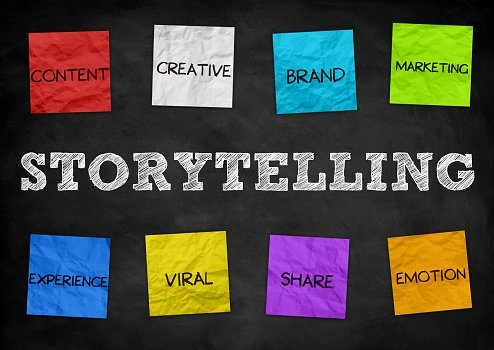
Brand Storytelling Vs. Content Marketing: What’s The Difference?
Your Brand’s Story Is Told Through Every Interaction Customers Have With You
 Let’s get this out of the way: Brand storytelling and content marketing are NOT the same thing. Brand storytelling is NOT simply a repackaged way to talk about content marketing.
Let’s get this out of the way: Brand storytelling and content marketing are NOT the same thing. Brand storytelling is NOT simply a repackaged way to talk about content marketing.
In fact, content marketing is just one of the many ways your brand’s story gets told. While content marketing is a component of brand storytelling, brand storytelling refers to a lot more than just content marketing.
So what are the differences, and which do you need to focus your efforts on?
Content Marketing Vs. Brand Storytelling
Content Marketing
Content marketing refers to the practice of publishing educational and promotional content for your prospects and customers.
Some of the most common types of marketing content that companies publish include:
- Blog posts
- Pillar pages
- Articles
- Videos
- Whitepapers
- Infographics
- E-books
- Quizzes
- InfoGuides
- Webinars
- GIFs
- Memes
With content marketing, brands become publishers, creating content around topics they know their audiences will be interested in. Typically, brands do this to:
- Attract new customers
- Engage an existing audience
- Create or reinforce brand loyalty
When a B2B company creates a pillar page to try to introduce new prospects to its brand and establish credibility on the subject, that is content marketing. When a B2C company creates an inspirational video to strengthen brand loyalty, that is also content marketing.
Brand Storytelling
Brand storytelling, on the other hand, is a broader category. It refers to every message your brand sends out, whether intentionally or unintentionally.
In addition to all of your marketing content, your brand story also includes:
- Your website pages, including product and services pages
- Your core value proposition
- Your differentiation messaging
- Your unique selling propositions
- The experiences your customers have using your products and/or services
- The reviews customers post about you online
- What your sales reps tell customers
- What your customer support team tells customers
- How your employees talk about your company to the people they meet
- Your social media content
- Your press releases
- Any coverage of your brand in the media
That’s a lot of moving pieces and, frankly, they are not all in the control of your marketing department. Does that mean you should give up hope and focus all your energies on other marketing initiatives? Definitely not.
Why And How Marketers Can Take Control Of Brand Storytelling
Your brand’s story plays an enormous role in how prospects and customers feel about you. That can make the difference between them purchasing from you or from a competitor.
In other words, you need to do everything you can to control your brand’s story.
How do you do that?
#1. Look At Your Brand Identity
When was the last time you went through a brand identity exercise? Take a look at your brand guidelines. What do they say about your company? Do you recognize your company in them? Does your logo still resonate? Do your brand colors? Do your mission statement and taglines sound like your company? If not, it may be time to go through a branding exercise.
As you consider these questions, it’s critical you don’t just consider the answers from the point of view of your marketing team. All of your company’s employees need to be able to recognize your company in your brand.
#2. Look At Your Company Messaging
Do your mission statement, taglines and boilerplate tell a very clear story about who your company is or what it does? Do they clearly and compellingly identify and explain your differentiators? If not, you’re not doing a great job telling your prospects and customers why they should choose you instead of your competitors.
To get your company messaging in a better place, go through a messaging exercise. Bring together a handful of key stakeholders from various departments including:
- Executive leadership
- Sales
- Products and/or service delivery
- Customer support
- Marketing
Have a frank conversation about what your customers are looking for when they consider a company like yours. Ask why they should do business with you instead of your competitors. Clarify whether the things you think are differentiators are actually claims only you can make.
From this conversation, draft a document that outlines your:
- Core value proposition
- Key differentiators
- Key selling propositions
- Mission statement
- Boilerplate
Once you’ve drafted this document, share it with the other key stakeholders from your messaging brainstorm. Do you have their buy-in? You need it, or else you’ll never get traction when you roll out the new company messaging to your whole organization. Rework your messaging until you have at least some level of buy-in from everyone in that meeting.
Then, begin rolling it out to larger groups of employees. Test how they respond to it and whether they think it accurately and ideally represents who you are as a company and as a brand.
Once you’ve gained buy-in from a broad range of the company, weave this messaging into your overall brand guidelines, including logos, color palette, imagery guidelines and fonts.
#3. Roll It Out To Your Whole Team
We can’t stress this enough: Your employees at large have to understand and buy into your brand messaging. If they don’t, it will fail.
The conversations your sales reps have with prospects affect your brand story. The conversations your support reps have with customers affect your brand story. The conversations your employees at large have with their friends, neighbors and social media connections all affect your brand story.
To make sure you have understanding and buy-in from your employees, develop a robust communications strategy. This could include:
- Sending company-wide emails
- Posting messages in company chat threads or portals
- Giving managers scripts to distribute to their teams
- Posting taglines and your boilerplate all over your offices
- Making videos you distribute to team members
Whatever you do, don’t assume your team will fully grasp your messaging the first time they read or hear it. Make sure every employee in your company has been exposed to your revamped messaging at least nine times.
#4. Distribute Your Brand Story To The World
Once your employees understand and have bought into your brand story, it’s time to roll it out to the world. That doesn’t necessarily mean some big PR push. In most cases, neither media outlets nor your customers will care that you’ve redone your messaging.
Look for opportunities to change website copy to reflect your high-level messaging. New messaging may even mean an entire website development project.
You also want to update other key assets that shape how you interact with the world to reflect your new messaging. These could include:
- Sales templates
- Previously published content marketing assets
- Battle cards and sales scripts
- Customer service scripts
- Chatbot workflows
- Email workflows
- Press release templates
- Social media assets, including boilerplate, header images and profile pictures
Make sure that all of the people creating content marketing assets, press releases and social media assets are doing so in line with your new messaging. If you’re trying to create a brand story that aligns with your new messaging but those creators are still working from the old messaging, you’re actually telling a different story than the one you think.
Finally, use your brand messaging guidelines to shape how your company responds to the world, including media coverage, social media responses, customer service issues and any PR crises that may arise.
4 Tips For Weaving Your Brand Story Into Your Content Marketing
The educational and promotional content you publish has a huge effect on your brand story. After all, your marketing content may be the first exposure your potential customers have to your brand. But how do you weave that story throughout your content without it becoming a distraction? Here are a few tips on how to do that:
#1. Make Your Customers The Heroes Of Your Story
In many ways, the problems your products and services solve are your brand story. Make sure your customers are the heroes of your story. Every piece of content you publish should give your customers another tool they can use to solve their problems and feel like a hero. Keep helping them solve their problems until they encounter ones they need your products or services to solve.
#2. Channel Your Brand’s Passions
Your prospects and customers are more likely to relate to your brand if it’s passionate about something. Even the driest, most technical brands have things they are passionate about. As you develop topics for your content strategy, make sure you allow space to publish about topics you’re passionate about.
#3. Tell Your Story Through Voice And Tone
Are you creating a brand that is helpful and friendly, or edgy and contrarian? Whatever your brand identity is, you need that identity to come through in your voice and tone. That gives you a way to shape how your customers feel about you even when you’re publishing about broader topics.
#4. Focus On Differentiation In Content For The Middle Of The Buyer Journey
There’s a reason you do certain things differently than your competitors. It comes from the belief that your approach will yield better outcomes and experiences for your customers. As you focus on content for the middle of the buyer journey, make sure to create educational content on why the way you do things is critical to your customers’ success.
Driving Toward Your Goals With Content Marketing And Brand Storytelling
You can’t control every element of your brand story. You also shouldn’t let your brand be the only factor influencing your content strategy.
But with a thoughtful focus on both your brand story and your content marketing, you can create an interconnected, omnichannel customer experience and buyer journey that guides prospects to you, builds their affinity for you and establishes you as the only logical and emotional choice to meet their needs.
CEO and Chief Revenue Scientist
Dan Reed
Eliminate Hit-or-Miss Marketing Moves
Get advice, tips, tools and guidance to generate more leads for your company in this weekly email newsletter.



Eliminate Hit-or-Miss Marketing Moves
Get advice, tips, tools and guidance to generate more leads for your company in this weekly email newsletter.













